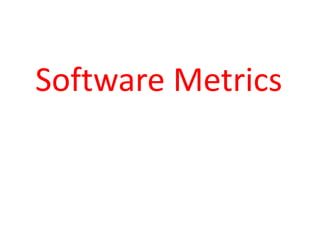Software Metrics (Testing)
- 2. ŌĆó Software metrics can be classified into three categories ŌłÆ ŌĆó Product metrics ŌłÆ Describes the characteristics of the product such as size, complexity, design features, performance, and quality level. ŌĆó Process metrics ŌłÆ These characteristics can be used to improve the development and maintenance activities of the software. ŌĆó Project metrics ŌłÆ This metrics describe the project characteristics and execution. Examples include the number of software developers, the staffing pattern over the life cycle of the software, cost, schedule, and productivity.
- 3. Metrics for the Process & Project domains: ŌĆó Project Metrics enable a s/w project manager to: ŌĆó 1.Assess the status of an on going project ŌĆó 2.Find the potential risks ŌĆó 3.Uncover the problem areas before they go critical ŌĆó 4.adjust work flow and work tasks ŌĆó 5.Evaluate the ability of project teams to control quality of work products.
- 4. Software Measurement Software is measured for many reasons: ŌĆó 1. To indicate the quality of the product. ŌĆó 2.To assess the benefits derived from new s/w engineering methods and tools. ŌĆó 3.To assess the productivity of the people who produce the product. ŌĆó 4.To form a baseline for estimation.
- 5. Measurements in the physical world can be estimated in two ways: ŌĆó 1.Direct Measurement(Ex: Length of Bolt) ŌĆó 2.Indirect Measurement(Ex: Quality of the Bolt produced) ŌĆó Direct Measures of the s/w engineering process include cost of effort, DM of the product includes lines of code, Execution Speed, Memory Size and defects reported etc..
- 6. ŌĆó Indirect Measures of the product include functionality, quality, complexity, efficiency, reliability, maintainability etcŌĆ” ŌĆó Software Metrics can be categorized into : ŌĆó 1.Size Oriented Metrics ŌĆó 2.Functioned Oriented Metrics ŌĆó 3.Human Oriented Metrics
- 10. Size Oriented Metrics ŌĆó Productivity=KLOC/Person-months ŌĆó Quality=Defects/KLOC ŌĆó Cost=$(000)?KLOC ŌĆó Documentation=Pages Per documentation/KLOC
- 14. Function Oriented Metrics ŌĆó Productivity=FP/Person-month ŌĆó Quality=Defects/FP ŌĆó Cost=$(000)/FP ŌĆó Document=Ppdoc/FP
- 19. Example for Cause Effect
- 20. ŌĆó Now letŌĆÖs try to implement this technique with some example. ŌĆó 1. Draw a cause and effect graph based on a requirement/situation 2. Cause and Effect graph is given, draw a decision table based on it to draw the test case. ŌĆó LetŌĆÖs see both of them one by one.
- 21. ŌĆó The ŌĆ£Print messageŌĆØ is software that read two characters and, depending on their values, messages must be printed. ŌĆó The first character must be an ŌĆ£AŌĆØ or a ŌĆ£BŌĆØ. ŌĆó The second character must be a digit. ŌĆó If the first character is an ŌĆ£AŌĆØ or ŌĆ£BŌĆØ and the second character is a digit, the file must be updated. ŌĆó If the first character is incorrect (not an ŌĆ£AŌĆØ or ŌĆ£BŌĆØ), the message X must be printed. ŌĆó If the second character is incorrect (not a digit), the message Y must be printed.
- 22. ŌĆó Solution: ŌĆó The causes for this situation are: C1 ŌĆō First character is A C2 ŌĆō First character is B C3 ŌĆō the Second character is a digit ŌĆó The effects (results) for this situation are E1 ŌĆō Update the file E2 ŌĆō Print message ŌĆ£XŌĆØ E3 ŌĆō Print message ŌĆ£YŌĆØ
- 23. First, draw the causes and effects as shown below:
- 24. ŌĆó In this example, letŌĆÖs start with Effect E1. ŌĆó Effect E1 is to update the file. The file is updated when ŌĆō The first character is ŌĆ£AŌĆØ and the second character is a digit ŌĆō The first character is ŌĆ£BŌĆØ and the second character is a digit ŌĆō The first character can either be ŌĆ£AŌĆØ or ŌĆ£BŌĆØ and cannot be both.
- 25. ŌĆó Now letŌĆÖs put these 3 points in symbolic form: ŌĆó For E1 to be true ŌĆō following are the causes: ŌĆō C1 and C3 should be true ŌĆō C2 and C3 should be true ŌĆō C1 and C2 cannot be true together. This means C1 and C2 are mutually exclusive.
- 26. So as per the above diagram, for E1 to be true the condition is (C1 C2) C3
- 27. ŌĆóThe circle in the middle is just an interpretation of the middle point to make the graph less messy. There is a third condition where C1 and C2 are mutually exclusive. So the final graph for effect E1 to be true is shown below:
- 28. ŌĆó LetŌĆÖs move to Effect E2: E2 states to print message ŌĆ£XŌĆØ. Message X will be printed when the First character is neither A nor B. Which means Effect E2 will hold true when either C1 OR C2 is invalid. So the graph for Effect E2 is shown as (In blue line)
- 29. ŌĆó For Effect E3. E3 states to print message ŌĆ£YŌĆØ. Message Y will be printed when Second character is incorrect. Which means Effect E3 will hold true when C3 is invalid. So the graph for Effect E3 is shown as (In Green line).




























